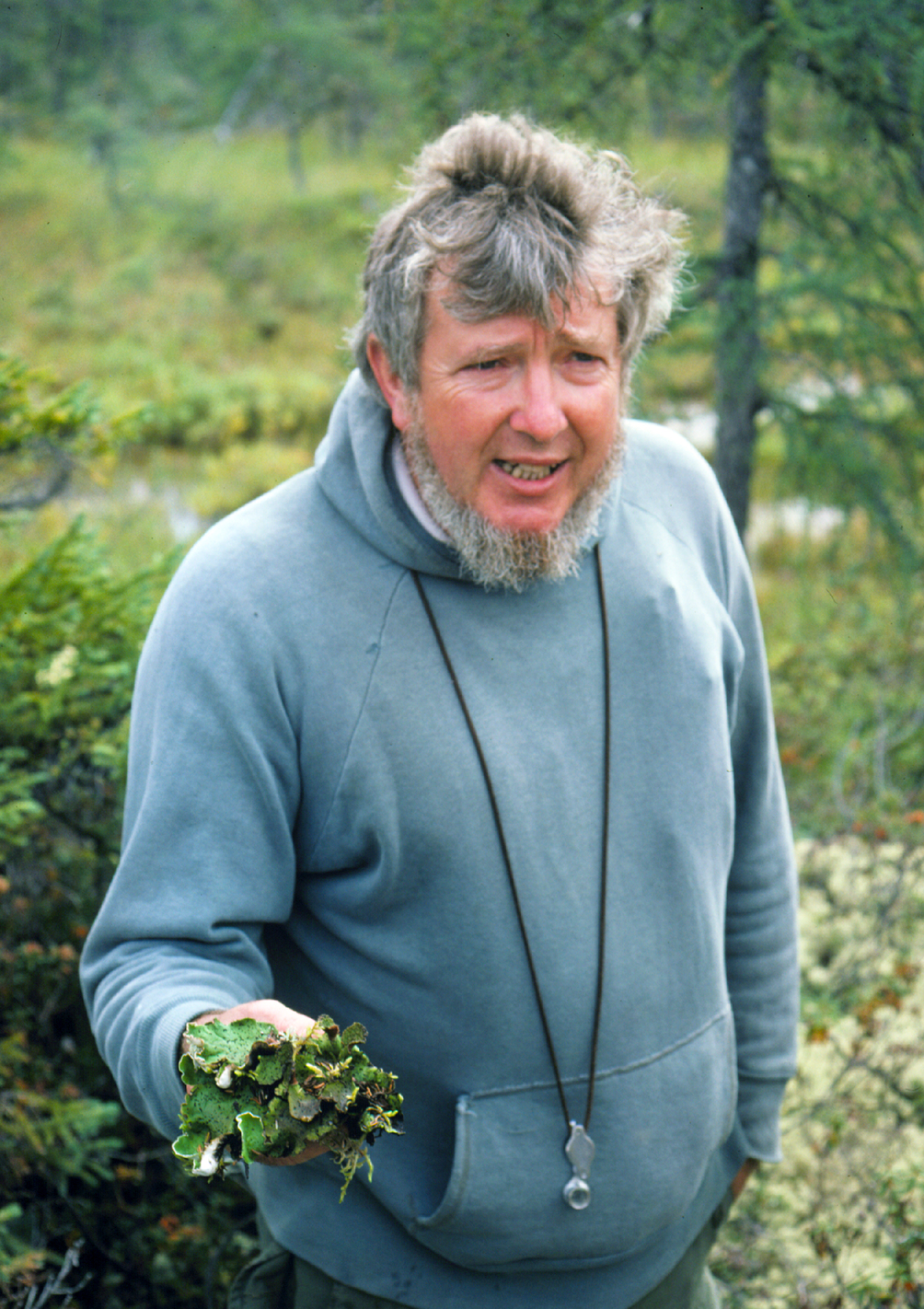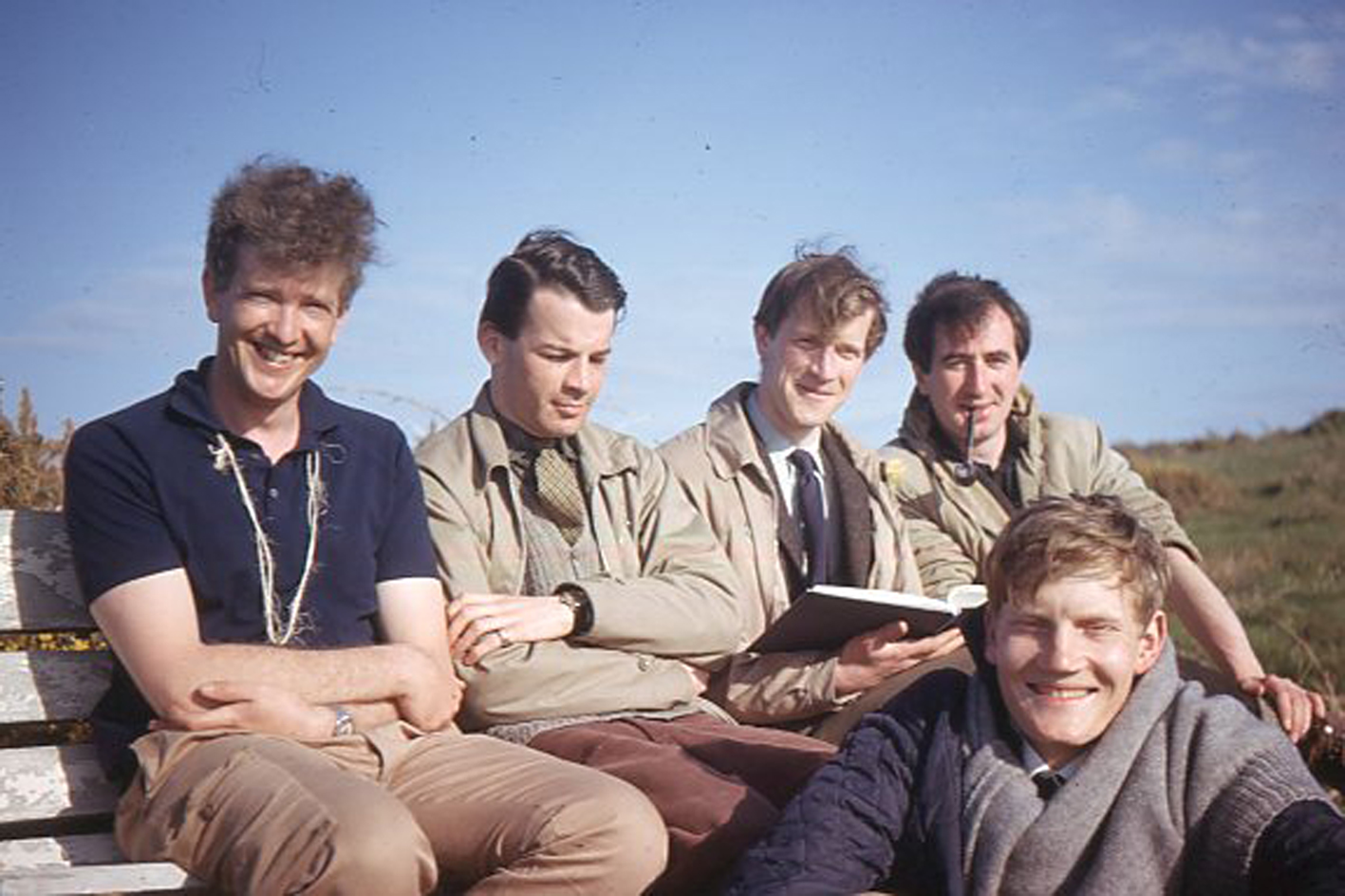Kenneth Andrew Kershaw, an active BLS member during the early years of the Society, died on 30 December 2019 aged 89. Ken made outstanding contributions to lichen ecophysiology and his publications remain the seminal works in several areas of the subject.
Ken was born in Lancashire in 1930 and grew up in Ashbourne, Derbyshire. He graduated in Botany from Manchester University in 1952 and then, after military service, undertook a PhD at the University of North Wales (Bangor) researching pattern in plant communities under the supervision of Peter Greig-Smith. Ken's interest in lichens no doubt grew during these years in Bangor. Fieldwork and walks in Snowdonia, often accompanied by fellow PhD student at Bangor and another lichen enthusiast, John Tallis, provided ample opportunities to hone identification skills. While taking recreational walks together along the Carneddau ridge between 1956 and 1958, Ken and John made novel observations on the dynamic nature of stone polygons which they published in Nature Reference Tallis and Kershaw1.
Following the award of his PhD in 1957Reference Kershaw2, Ken moved to a lectureship in the Botany Department at Imperial College. Here he continued research on pattern in vascular plant communities, both in Britain and further afield while participating in Imperial College expeditions to Norway and Iceland, and in Nigeria during a period of secondment to Ahmadu Bello University in Zaria. He published Quantitative and Dynamic Plant Ecology in 1964Reference Kershaw3, subsequently revised twice, and he soon was in the vanguard of applying computer science to vegetation analysis and predictive modellingReference Kershaw4,Reference Rutter, Kershaw, Robins and Morton5 . At the same time, Ken's interest and research effort in lichenology grew considerably while at Imperial. He contributed several papers to early issues of The Lichenologist, including synopses of Stereocaulon Reference Kershaw6 and Umbilicaria Reference Kershaw7 in Britain, and published The Observer's Book of Lichens Reference Alvin and Kershaw8 in 1963 together with Kenneth Alvin of Birkbeck College; he also provided line drawings for Ursula Duncan's Lichen Illustrations Reference Duncan9 and Introduction to British Lichens Reference Duncan10. John Sheard and Graham Harris were both PhD students under Ken's supervision working on the genus Rinodina Reference Sheard11 and the ecophysiology of epiphytic lichensReference Harris12, respectively. Ken was not a co-author of their published output, just as Peter Greig-Smith had not been a co-author of Ken's, but this practice changed thereafter. Graham Harris compared photosynthetic responses among lichen species occupying different elevational niches in tree canopies using a technique that enabled net CO2-exchange to be tracked as a lichen thallus dried, an approach that Ken would go on to develop further. In the late 1960s, Ken began working on nitrogen fixation in lichens in collaboration with John Millbank, a microbial biochemist at Imperial. In two benchmark papersReference Millbank and Kershaw13,Reference Kershaw and Millbank14 they showed that nitrogen fixed in cephalodia of Peltigera ‘aphthosa’ (= P. britannica) moves into the fungal component of the thallus but not, in any significant quantity, into the green algal partner. John Millbank continued this research but Ken, frustrated with limited opportunities for promotion at Imperial College despite the award of a DSc in 1968, moved to Canada in 1969 to a chair in plant ecology at McMaster University in Hamilton, Ontario.

Fig. 1. Ken Kershaw in 1978 teaching arctic plant ecology to students at the Churchill Northern Studies Centre (photograph courtesy of D. Coxson).
Canada's boreal arctic environments provide bounteous opportunities for lichen research and Ken grabbed them with both hands. He found a kindred spirit in Wayne Rouse, a microclimatologist in McMaster's Geography Department, and they initiated research programmes in northern Ontario, on the Hudson Bay Lowlands and in the Northwest Territories. They launched Studies on lichen-dominated systems Reference Kershaw and Rouse15, a series of papers published in the Canadian Journal of Botany that reached 23 contributions by 1980. The main thrust of this research was the identification of pattern in lichen-dominated plant communities and explaining the observed patterns in terms of variation in, and lichen response to, microclimate. Papers in this series examined spatial differences in evaporative forces and lichen drying rates, photosynthetic adaptation to contrasting thallus hydrologies, and how lichen physiology changes seasonally, or acclimates, to track changing microclimateReference Larson and Kershaw16. Subsequent papers in the series dealt with lichen-dominated woodland, including a description of the fire-induced cyclic succession in which Stereocaulon woodland is an intermediate stageReference Maikawa and Kershaw17, and an analysis of regional climatic differences underlying the contrasting development of Stereocaulon woodland in north-central Canada and Cladonia-dominated forest in other regionsReference Kershaw18. Concurrent with this subarctic research, Ken published 17 papers in the series Physiological-environmental interactions in lichens Reference Kershaw19 in the New Phytologist, largely dealing with seasonal changes in photosynthetic capacity and nitrogenase activity in Peltigera spp. collected in the Hamilton region, but also including work on such topics as the environmental control of carbon movement from photobiont to mycobiont, and thermal stress in lichensReference Tegler and Kershaw20. Ken published many papers in addition to those in these signature series, including in Nature Reference Larson and Kershaw21, Science Reference MacFarlane and Kershaw22 and Plant Physiology Reference Brown and Kershaw23. He introduced a plethora of conceptual and methodological innovations such as the dynamic nature of thallus physiology, the relationship between thallus colour and heat load, and techniques for measuring light penetration in lichen mats and thallus drying rates. A sequence of Ken's research students and post-docs contributed to this output. Douglas Larson was one such student studying physiological differentiation among lichen species occupying contrasting ecological niches in coastal tundra. Finding the open cuvette system for measuring net CO2-exchange used previously by Graham Harris at Imperial College overly cumbersome, Doug and Ken in 1974 switched to using small closed glass cuvettes that could be manipulated quicklyReference Larson and Kershaw24; CO2 was measured by injecting discrete subsamples of cuvette head space gas into an infra-red gas analyser. This revolutionized the capacity to make rapid sequential measurements of lichen net photosynthetic rates under laboratory conditions and underpinned much of the subsequent research by Ken's group. This impressive research record was recognized in Ken's election to Fellow of the Royal Society of Canada in 1980, and summarized in Physiological Ecology of Lichens Reference Kershaw25 published in 1985.
Ken was also an inspirational teacher and at the forefront of teaching the application of computers in ecology. At Imperial College he ran a field course on bryophytes and lichens based at Bangor (together with Kery Dalby) and at McMaster he led a course on arctic plant ecology at the Churchill Northern Studies Centre in northern Manitoba; both were very well received by students.

Fig. 2. Ken Kershaw (left) in 1966 at the BLS field meeting in the Channel Islands, together with (L to R) Gareth Morgan-Jones, Peter James, Michael Mitchell and David Richardson (photograph courtesy of D. Richardson).
Ken had a flair for cooking and was a congenial, entertaining and generous host such that social evenings at Ken's house were looked forward to and subsequently rarely forgotten. He loved a good story with which to regale an audience and events during the summer of 1975 were the basis of one of his best. Ken was at his research site at East Pen Island on the Hudson Bay Lowlands with members of his research group when reluctantly he had to shoot a polar bear that was menacing the camp and damaging equipment. Some days later Ken and a few of the group were returning from a mini expedition into the forest tundra to the south. As the weary party walked across the tundra, the trailer wagons of the research camp came into view and they were horrified to see another, very large polar bear attempting to climb onto the roof of one of the wagons in pursuit of the incumbents. The gun was at the camp and Ken could only keep low and watch. Fortunately, a field assistant shot the bear and Ken made it back safely. In order to fetch the gun a master's student had made a hair-raising dash to a neighbouring trailer chased by the bear. As it happened, this was the first summer that Ken had taken a firearm into the field. Ken's wife, Ellen, mindful that he was responsible for the safety of his students, became alarmed that he had no means of protecting them from a bear attack. Reluctantly, Ken ordered a Lee-Enfield .303 rifle from the Simpsons-Sears catalogue and it was promptly delivered in the mail together with ammunition. The story made a big splash in the local press and at many of Ken's dinner parties for years to come.

Fig. 3. Ken (in striped shirt) in 1960 working in Iceland on an Imperial College expedition studying pattern in a Carex bigelowii–bryophyte community (photograph anon.).
Ken retired in 1988 but he didn't ‘slow down’. He had collected antique maps and prints for many years as a hobby and during his later years at McMaster he had established a successful antique map business, ‘Kershaw Old Maps and Prints’, which he continued into retirement. Later, on selling his map stock, Ken assisted his son Matt in opening and running a restaurant for fine dining in Ancaster, near to his home (Rousseau House Restaurant). This was followed by a passion for collecting and studying old Canadian stamps. Ken gained recognition as an expert on both early Canadian maps and early Canadian stamps and he published several books on both subjects.
Ken Kershaw often said that he could think of no more pleasurable a career than scientific research. His enthusiasm for ecology and lichen biology was infectious and motivating. He had a gift for writing and he published prolifically, leaving the field profoundly enriched.
I thank Brian Coppins, Darwyn Coxson, Heli Hurme, Douglas Larson, John Henry Looney, Alan Morton and John Tallis for their comments on an earlier draft of this account, Mark Seaward for supplying from the BLS archives the photograph of Ken Kershaw at the BLS meeting, and David Richardson for information pertaining to Ken Kershaw's career at McMaster University. I also appreciate being given access to John MacFarlane's account of the polar bear incidents.







